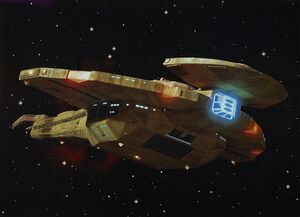Galor class/Design History & Achievements: Difference between revisions
Oddas Aria (talk | contribs) (Adding a picture.) |
Oddas Aria (talk | contribs) (fixing up the header) |
||
| Line 1: | Line 1: | ||
{{Utopia Planitia Non-Federation}}__NOTOC__ | |||
{{Cardassian Fleet}} | |||
{{Galor Menu}} | {{Galor Menu}} | ||
The early concept of the Galor Class began to take shape circa 2310 as the Cardassian High Command realized the need for a heavier capital ship to further expand their empire and ensure their superiority within that empire and to aid in their expansion. The first Galor class hull was laid down in the Monac shipyards in 2312, and was completed in early 2314. The prototype proved to be agile, powerful and resilient in battle, its weapons systems and shields powered by one of two M/AM reactors. The design allowed the Galor Class to engage battle longer than its contemporaries - remaining when its contemporaries would either retire, suffer damage, or worse. | The early concept of the Galor Class began to take shape circa 2310 as the Cardassian High Command realized the need for a heavier capital ship to further expand their empire and ensure their superiority within that empire and to aid in their expansion. The first Galor class hull was laid down in the Monac shipyards in 2312, and was completed in early 2314. The prototype proved to be agile, powerful and resilient in battle, its weapons systems and shields powered by one of two M/AM reactors. The design allowed the Galor Class to engage battle longer than its contemporaries - remaining when its contemporaries would either retire, suffer damage, or worse. | ||
Latest revision as of 14:56, 1 February 2021
| Utopia Planitia Fleet Yards |
|---|
|
CARDASSIAN FLEET
The production of the Galor Class offered the Cardassians complete control over their space, and allowed them to extend their reach without serious opposition until they encountered the Federation in the 2340’s. One serious drawback to the weapons suite of the Galors was severe overheating of its weapons coils, a design flaw not completely overcome. As Galor class vessels were not usually deployed singly during a campaign, it was thought most engagements would not last long enough for the flaw to be a serious issue. Another flaw made apparent through extended use was the overload of power transfer conduits. Overloaded power conduits caused during battle, high warp operations, or other high power uses as the Galor’s ability to transfer from one reactor to another would be compromised. The Galor class was contemporaneous of Starfleet’s Miranda class, which the Galor could overpower with shields, size, and firepower. The introduction of Starfleet’s Galaxy Class saw a change in dynamic, which found the Galor outmatched during one on one engagements. This change in the overall strength was one factor in the decision to supplant the Galor with the Keldon Class Some commentary has been made whether the above 'flaws' should be classified as such, considering the differing design strategies of the Cardassian Union at the time of the Galor's construction. The design philosophy was one of limited resources which forced certain design trade-offs to be made, including the lack of certain redundancies and the acceptance of wider precision in the manufacture of certain parts. Some records indicate the Cardassians themselves saw some of these 'flaws' not as drawbacks but as advantages that allowed them to produce more vessels in a shorter period of time. |


